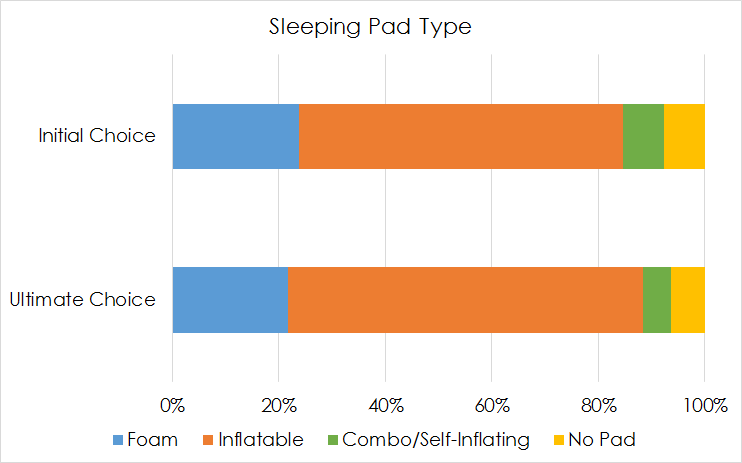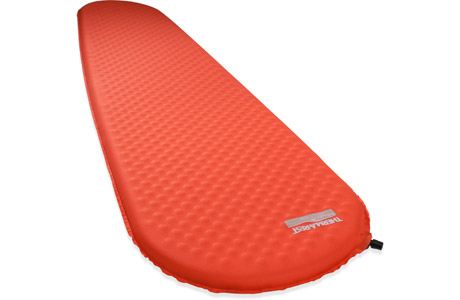By the Numbers: Sleeping Pads on the Appalachian Trail
Also, check out the previous post covering which sleeping bags 2015 AT thru-hikers used.
I admit, my sleeping pad was just an afterthought during my thru hike.
I extensively researched sleeping bags, but when it came to pads, I just scavenged my parent’s basement for an old yoga mat.
However, anyone who has ever found themselves camped in a puddle of rain water can tell you that inflatable pad keeps you high and dry when a foam pad does not. And anyone who has ever tried to perch on an inflatable pad inside a hammock can attest that sleeping pad choices are actually pretty important.
So yes – sleeping pad options are arguably more straightforward than shelter systems, stoves, or other gear items. However, upon surveying 156 long-distance hikers who walked the AT in 2015, I found that sleeping pad choices were more interesting than I expected.
The Sample
Thru-hikers or those who walked over 2,000 miles comprised 61 percent of hikers in our survey, while 39 percent were section hikers. Roughly two thirds (63.5%) were male and one third (36.5%) were female. The majority of hikers (60.3%) were in their twenties, but those in their thirties (14.7%) and fifties (12.2%) were also well represented.
Sleeping Pad Types
Sleeping pad types are pretty straightforward. The options are basically foam, inflatable, or combination/self-inflating pads that have a thin layer of foam and also rely on air for comfort. (For a more detailed explanation, check out Madi Dragna’s breakdown of sleeping pads).
Almost one third of hikers (30.7%) changed sleeping pad models at some point during their trek, but generally types of pads hikers preferred did not change: over two thirds of hikers preferred inflatable pads.
Pads and Shelter Systems
However, upon examining pad type compared to shelter system, some differences in pad preference emerged.
Hammockers used foam and combination pads to about the same extent as other hikers, but were much less likely to use inflatable pads and more likely to use no pad at all.1 Based on my personal experience, inflatable pads inside hammocks don’t work very well at all. Underquilts are generally optimal for hammocking. However, I chose a foam pad because it worked OK inside a hammock and also worked when sleeping in the shelters/lean-to’s along the AT.
Alternatively, tenters were less likely than users of other sleep systems to go without a sleeping pad.2 It makes sense that hikers who want more comfort and protection in their shelter system would likely prefer to use a sleeping pad.
Not only did we find that sleeping pad type was associated with shelter type, but we found that hikers who changed shelter systems were also 2.6 times more likely to change sleeping pad types (even after accounting for distance hiked, age, and gender).3 This suggests that it isn’t just important to have a good quality sleeping pad; it is important to have a pad that works well with the sleep system you chose. Be prepared to change pads (or be uncomfortable) if you change sleep systems, and vice versa. Because sleeping pads are generally cheaper and simpler than shelter systems, I suggest first testing out and determining your shelter system and secondly choosing a sleeping pad.
Brands and Models
The predominant brand of sleeping pad was Therm-a-Rest, used by 91 out of 156 hikers in the survey.
The most popular foam pad models were from the ZLite/ZLite Sol series, used by at least 15 hikers.
The Therm-a-Rest NeoAir pads – including NeoAir Trekker and NeoAir XLite – were the most popular inflatable pads, used by at least 42 hikers in the survey.
The common combination/self-inflating pads were from the Therm-a-Rest ProLite series (13 hikers).
TL;DR and Implications for Future Hikers
- Matching your pad to your shelter system appears important enough that hikers who switch shelter systems will likely switch sleeping pads as well.
- Because sleeping pads are generally cheaper and simpler than shelter systems, I suggest first testing out and determining your shelter system and secondly choosing a sleeping pad.
- Inflatable pads are the most popular sleeping pad type among AT long-distance hikers, and among tent users in particular. The most popular inflatable models are from the Therm-a-Rest NeoAir series.
- Combination/self-inflating pads, considered more lightweight than foam pads and easier to use than inflatable pads, are newer and still only used by a minority of hikers. The most common models are from the Therm-a-Rest ProLite series.
- Among hammock users, inflatable pads are especially unpopular. Most hammock users choose foam pads or no pad at all (typically an underquilt instead). The most popular foam pads among AT long-distance hikers are from the Therm-a-Rest ZLite/ZLite Sol series.
- It was uncommon for hikers to forgo sleeping pads altogether, and those who did were predominantly hammock users. Unless you plan exclusively to hammock, NEVER using the lean-to shelters, it is not recommend that you go without a sleeping pad.
¡Muchas Gracias!
Congratulations to all who completed section and thru-hikes in 2015, and many thanks to those who participated in the survey. Thanks also to Zach Davis for his assistance.
More Gear By the Numbers
This is the fifth post in this series from our 2015 survey. Check out the previous posts on backpacks, sleeping bags, footwear, and shelter systems.
Notes for the Nerds
- A Chi-Square test of independent samples was conducted on sleeping pad use by shelter system. X2 = 64.48, df = 12, N = 141, p < .001. Post hoc tests were conducted interpreting standardized residuals as z-scores. Hammock by Inflatable Pad z = -2.3, p < .05; Hammock by No Pad z = 5.5, p < .001.
- Tent by No Pad z = -2.7, p < .01.
- A binary logistic regression was conducted predicting switching sleeping pad type (1) vs. same model replacements or no change (0). Age, Gender, and Distance Hiked were entered in Block 1; Sleeping Pad Type and Changed Shelter Models were entered in Block 2. The final model was not significant (p = .516). The only significant predictor was Changed Shelter Models (p = .028, Odds Ratio = 2.60, B = .956).
This website contains affiliate links, which means The Trek may receive a percentage of any product or service you purchase using the links in the articles or advertisements. The buyer pays the same price as they would otherwise, and your purchase helps to support The Trek's ongoing goal to serve you quality backpacking advice and information. Thanks for your support!
To learn more, please visit the About This Site page.







Comments 4
I use big Agnes System bags with my hammock. These bags have an integrated sleeve in the bottom for the air mattress and are cut loose enough so that the pad stays under you no matter how you roll around. I use a Big Agnes Q core SL. I don’t like the underquilt because it is basically useless if you decide to sleep in a shelter.
Love your analysis. Survey information is useful
I prefer hammock camping, and use an inflatable Klymit pad inside my sleeping bag…not much chance for it to move around. Packs so small it can stay insie my pack, not exposed with a chance of getting wet. My $.02
I’m a 60 yo male section hiker and use a Therm-a-Rest Women’s NeoAir XLite stuffed inside my sleeping bag. I alternate between taking a lightweight hammock or sleep in shelters (carry tarp if shelter space not available) . At my age, I want weight kept as low as I can; down to 28 pounds with five days of food and three liters of water (I seldom carry three liters but include the weight for planning purposes).
I might give a foam pad another shot based on your info. – Thanks